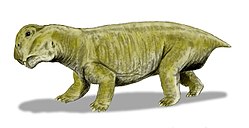| Kingoriidae | |
|---|---|
 | |
| Restoration of Dicynodontoides recurvidens | |
| Scientific classification | |
| Kingdom: | Animalia |
| Phylum: | Chordata |
| Clade: | Synapsida |
| Clade: | Therapsida |
| Clade: | † Anomodontia |
| Clade: | † Dicynodontia |
| Clade: | † Kistecephalia |
| Family: | † Kingoriidae King, 1988 |
| Genera | |
Kingoriidae is an extinct family of dicynodont therapsids. It includes the Late Permian Niassodon , [2] Thliptosaurus , [3] Dicynodontoides (initially called Kingoria) and the Triassic Kombuisia . [4]




